We already expressed a couple of thoughts and remarks on a paper published in Mediterranean Archaeology and Archaeometry in which Martin B. Sweatman and Dimitrios Tsikritsis have suggested (original article accessible here: [external link]) that the early Neolithic monumental enclosures at Göbekli Tepe were space observatories and the site’s complex iconography the commemoration of a catastrophic astronomical event (‘Younger Dryas Comet Impact’).
Meanwhile we were putting together a more elaborate reply with further arguments and references which, in our opinion, challenge the interpretation and add more context to the paper’s discussion of Göbekli Tepe’s iconography in the light of the early Neolithic in Upper Mesopotamia. The editors of Mediterranean Archaeology and Archaeometry kindly agreed to publish our response in the same journal as the original article by Sweatman and Tsikritsis.
The paper (J. Notroff, O. Dietrich, L. Clare, L. Dietrich, J. Schlindwein, M. Kinzel, C. Lelek-Tvetmarken, D. Sönmez: More than a vulture: A response to Sweatman and Tsikritsis. Mediterranean Archaeology and Archaeometry 17(2), 2017, 57-63.) can be accessed online: [external link].
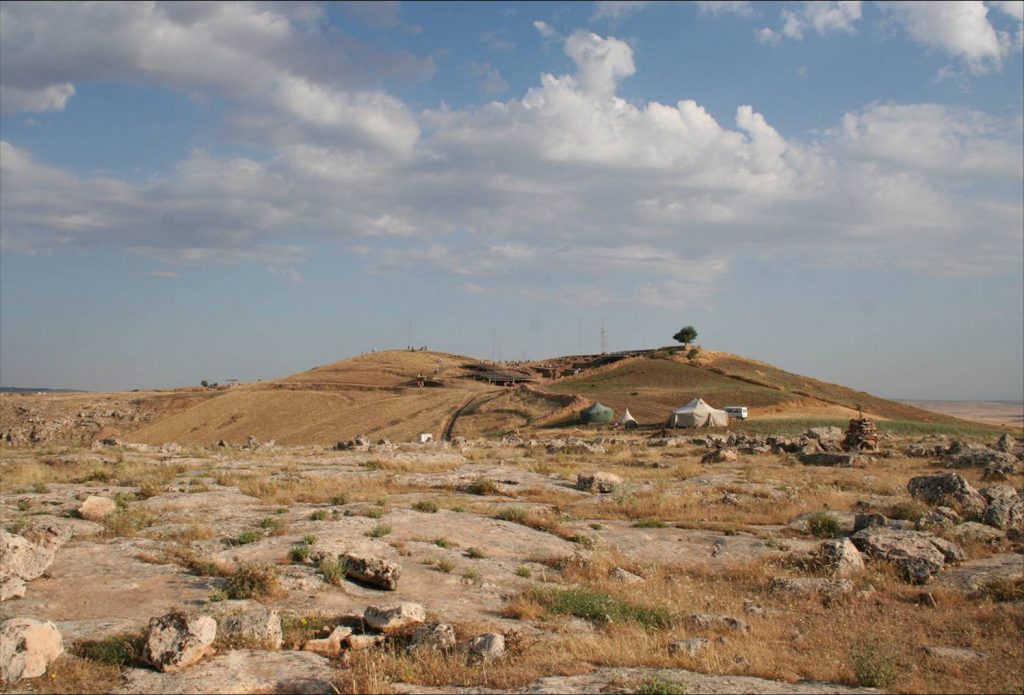
The mound of Göbekli Tepe seen from the south. (Photo: K. Schmidt, DAI)
Our reservations, which are not meant to silence any further archaeoastronomic discussion for Göbekli Tepe at all but rather comment on a number of discrepances we see in the interpretation, are summed up here:
1. The original layout of Göbekli Tepe’s monumental round-oval buildings is still subject of ongoing research (none of these structures are completely excavated as of yet). One should be aware that many of the T-pillars incorporated into the enclosures at Göbekli Tepe are not standing in their original positions and the buildings underwent significant modification during their life-cycles. Building archaeology studies have revealed that in many cases pillars were ‘recycled’, i.e. pulled out and used elsewhere. The monuments as we see them today are the culmination of multi-phase building and rebuilding events. Additionally, there is the significant possibility that we are dealing with roofed structures; this fact alone would pose limitations to a function as sky observatories.
2. The chronological frame Sweatman and Tsikritsis suggest for Pillar 43 (10950 BC +/- 250 years) is still 700-1000 years older than the oldest radiocarbon date so far available for Enclosure D (which stems from organic material retrieved from a wall plaster matrix). While there is evidence for later re-use of pillars (see above), assuming such a long tradition of knowledge relating to an unconfirmed (ancient) cosmic event appears extremely far-fetched. So far, any available date for Göbekli Tepe rather marks the end than the beginning of the Younger Dryas.
3. The assumption that asterisms are stable across time and cultures is not convincing. It is highly unlikely that early Neolithic hunters in Upper Mesopotamia recognized the exact same celestial constellations as described by ancient Egyptian, Arabian, and Greek scholars, which still populate our imagination today.
4. Sweatman and Tsikritsis’ contribution appears incredibly arbitrary, considering images adorning just a few selected pillars. Meanwhile more than 60 monumental limestone T-pillars are known from Göbekli Tepe – among these many feature similar carved low reliefs of animals and abstract symbols, a few even as complex as Pillar 43 (e.g. Pillar 56 in Enclosure H). Furthermore, the iconographic programme is not restricted to the limestone pillars; it is known from other find groups (including stone vessels, shaft straighteners, and plaquettes) not only from Göbekli Tepe but also from numerous contemporary sites in the wider region.
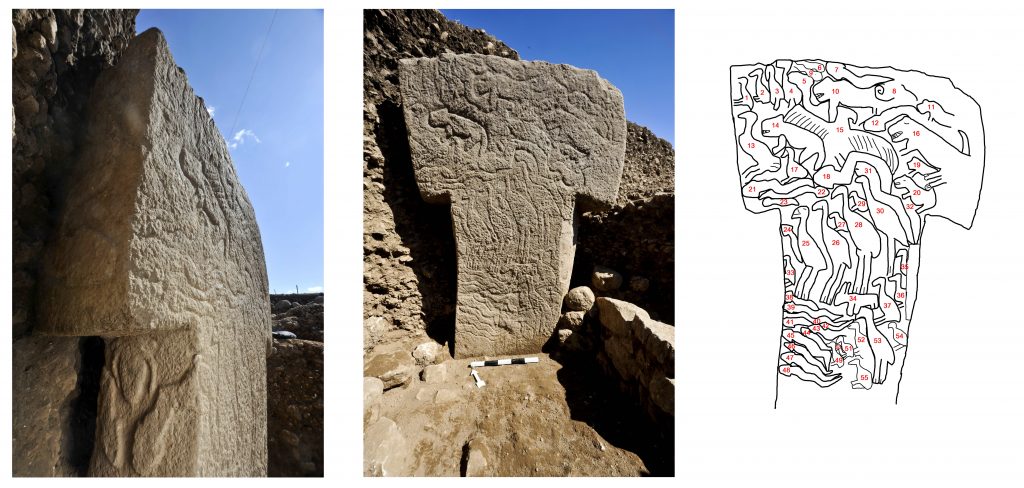
Pillar 56 from Enclosure H is another example for the rich and often complex iconography of Göbekli Tepe. (Photos & drawing: N. Becker, DAI)
5. Göbekli Tepe’s iconography is actually even more complex than the paper suggests. The animals depicted on the pillars seem to follow an intentional pattern, whereby each building has a different emphasis, i.e. with one animal or more being especially prominent. If we interpret these differences as an expression of community and belonging, this could hint at different groups having been responsible for the construction of particular enclosures. In other words, specific enclosures may have served the needs of different social entities. For this reason, it is extremely problematic to pick out any one pillar and draw far-reaching but isolated interpretations while leaving out its context. A purely substitutional interpretation ignores these subtler but significant details. Details like the headless man on the shaft of Pillar 43, interpreted as a symbol of death, catastrophe and extinction by Sweatman and Tsikritsis, silently omits the clearly emphasised phallus which must contradict the lifeless notion; rather, this image implies a more versatile narrative behind these depictions. It should also be noted that there are even more reliefs on both narrow sides of Pillar 43 which apparently went unnoticed in the study at hand.
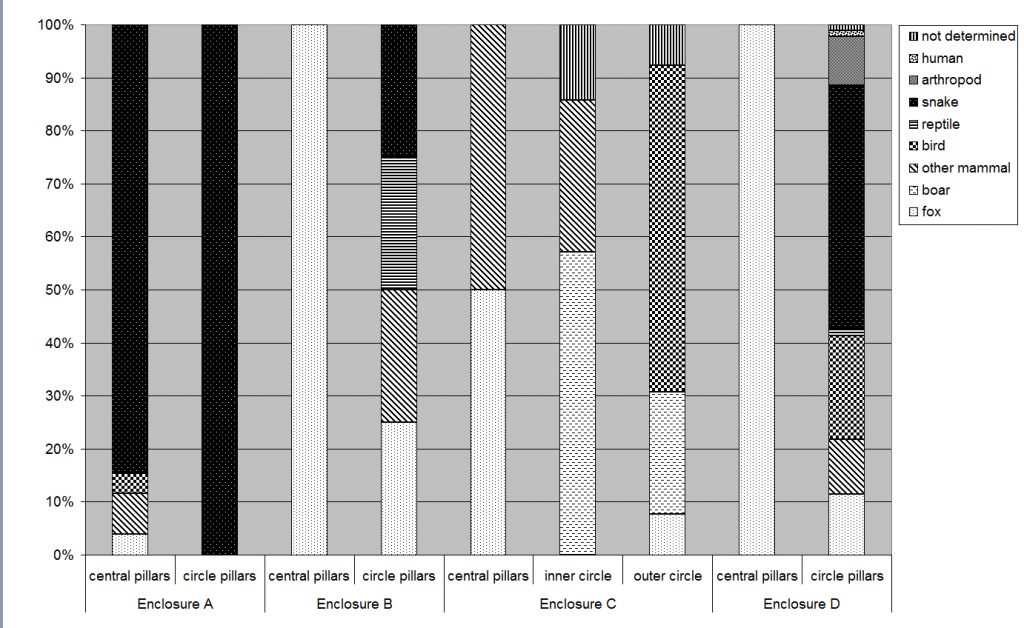
Distribution of the appearance of figurative representations in the enclosures of Göbekli Tepe. Note: The different state of excavation as well as chronological depth of construction periods have to be considered; later added graffiti as well as symbolically reduced icons were not included. (Graphic: J. Notroff & N. Becker, DAI)
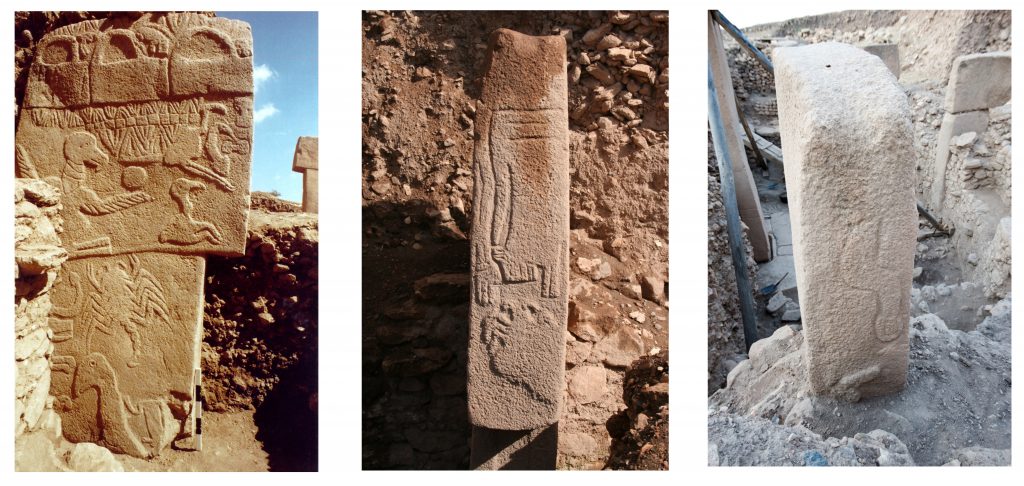
Pillar 43 from Enclosure D and its particularly rich relief-decoration – actually extending not only on the pillar’s western broadside (left), but also the southern (middle) and northern (right) narrow sides. (Photos: K. Schmidt, N. Becker, DAI)
Pre-Pottery Neolithic iconography, by far exceeding the realms of Göbekli Tepe, is often especially concerned with articulation and disarticulation of the human body. Particularly the depiction of severed human heads or headless bodies in combination with necrophagous animals (preferably but not exclusively vultures) is a well-known theme and may be rooted in a complex multiphase Pre-Pottery Neolithic mortuary ritual. Similar depictions of a bird grasping a human head are known from Göbekli Tepe as well as life-sized human sculpture heads which were deposited within the buildings.
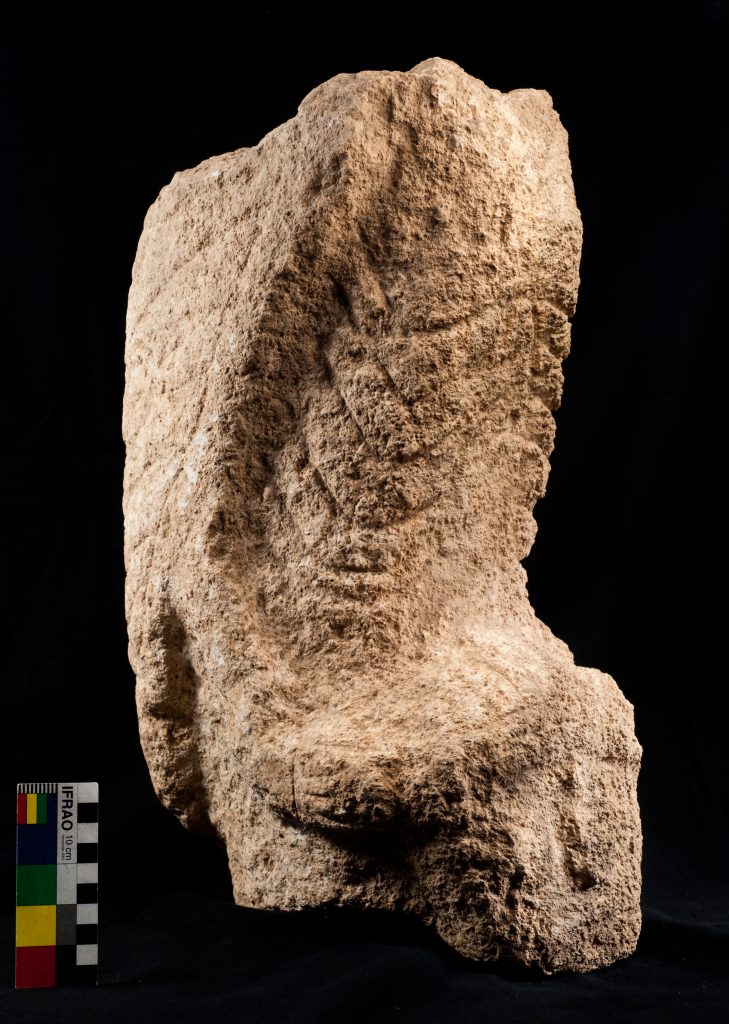
Fragmented sculpture from Göbekli Tepe showing a bird of prey crouched on a human head. (Photo: N. Becker, DAI)
Meanwhile both authors of the orginal study replied to our response (same issue of MAA, see link above), stressing that “… given the statistical basis o[f] [their] interpretation, any interpretation inconsistent with [theirs] is very likely to be incorrect.” (Sweatman and Tsikritsis, Comment, MAA 17(2), 66). Admittedly though, we still would like to express our doubt that human creativity really can be treated as a statistical case solely.
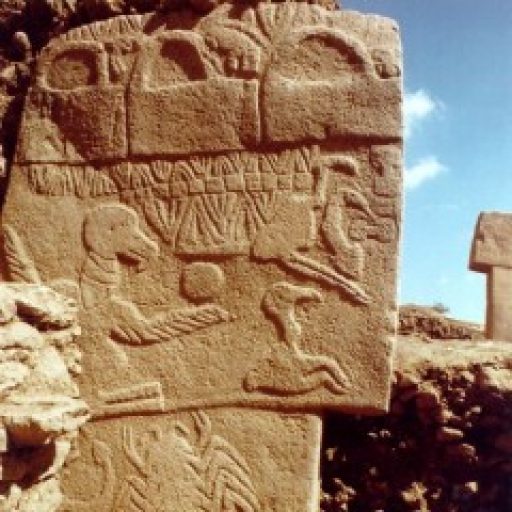
Why do you even reply to these alien-creation crackpots? Their nonsense only detracts from scientific analysis and credible human evolution.
It was a scientific article published in a scientific, peer-reviewed journal we were replying to. In the same journal. That’s academic common practice.
Just to add that (luckily) nobody has talked about aliens so far. As Jens also said in the post, we are not against archaeoastronomy. We observed severe flaws in the line and logic of argumentation in one particular article and see no reason to connect Göbekli Tepe to the hypothetical Younger Dryas Impact Event. We made that clear in a response to that article. To me this isn’t a waste of time, it’s science.
William, this is how science works. Science is only science when it is underpinned by evidence expressed in statistical terms with an estimate of confidence. We therefore provided a detailed scientific argument that Jens and his colleagues avoided in their response. Any other kind of ‘evidence’, without a statistical estimate of confidence, is not scientific – it is merely opinion. From your comment I can only presume you did not actually read our paper, as we did not mention aliens or creation once. You might also find our response to Jens and his colleagues interesting – Vol 17, issue 2 of the same journal.
I had the same reaction initially, but if these kinds of “crackpot” theories, presented as they are with a veneer of scientific analysis and thus managing to find their way into reputable journals are not adequately responded to, real scientists run the risk of having the integrity of their field slowly eroded. I stumbled onto Mr. Sweatman’s blog by accident, and did not know enough about the field to recognize it as pseudoscience. Fortunately, reputable scientists such as the authors of this article responded to Mr. Sweatman, and eloquently pointed out his scientific illiteracy. For that I am grateful.
Why is the bird on 43 designated as a vulture, rather than perhaps any other bird of prey?
Determinations are done by our archaeozoologists. In this case shape of head and beak, as well as the pattern visible in the neck area are important arguments.
Yes, it’s in particular the beak and the characteristic collar giving away this one. Plus: vultures are significantly present among animal bones as well.
E4A Admin:
And this is clearly reflected in the visible astronomy:
Download this extract from my investigation – produced specifically to add here – at https://farm5.staticflickr.com/4294/35845652391_71e530e6b3_b.jpg.
Or perhaps the image might be made available here, if not too large.
[img]https://farm5.staticflickr.com/4294/35845652391_71e530e6b3_b.jpg[/img]
Much better image, but not yet good enough. The Sun is on the ecliptic this time, but your vulture is ‘artistically’ /inclined/, whereby the one on the pillar is not – it is horizontal! What you are missing is that the Sun is supposed to be at sharp zenith to mark the solstice, as viewed locally on a gnomon. Never mind the fact that the actual crossing into Cancer sign is at some other time. But, while the Sun is at zenith, the constellation of Vulture is indeed horizontal, whilst Scorpio, and Libra are above the horizon, as depicted, so horizon is supposed to be at ground level, not at the head level, as you drove it this time.
So, for the next iteration, I suggest that you redraw the image with Sun placed at zenith, for the solstice day on years 10,952 – 10,949 BC, and match it with the (Vulture & sun disc) from the pillar, as drawn upon it. If you do, you might notice several interesting, and very indicative details.
Second remark: please mention the time of day for the picture (preferably in UT), it is very important for replication, and if possible use Gregorian calendar referencing, because that promptly indicates the discrepancy from the June 22 solstice that we are accustomed to.
Third, what precession formula have you been using for calculating the ecliptic of date ? (I presume the ephemeris is DE431).
Casual Visitor:
i) Sorry, but the image is more than good enough for the purposes of confirming that the Vulture/Sun Disc sculpture is REPRESENTATIVE of the date at summer solstice. If you believe that I have missed anything then it is for you to present your own interpretation, and of course I will be more than interested to see this, when in due course you publish as you appear to have indicated that you will do so.
ii) Personally, I think you are considerably over complicating the matter by wishing to be so accurate to time. If they wanted to express precise time then they would have shown it. I have not overlooked that perhaps indeed they did by the rectangular boxes below the “handbags”, if they represent the hours passed on this day. However, I don’t believe that these represent the time of day, and what I do believe they represent is a matter for me when I publish in due course, so I am, regrettably to those who might wish to read further discussion, not prepared to do so here.
iii) Sagittarius would not have been visible at this time of year. However, the position of the constellation is fixed throughout the year, and so it’s rising position, and any step along its path, would easily have been able to be marked during those times of the year/day when it could have been observed in a dark sky. The image clearly shows Sagittarius as above the local horizon – as generated using the “Horizon” astronomy program, created by Andrew Smith. This is not necessarily precise, but more than sufficiently indicative in the absence of a theodolite survey supported by photography.
iv) We are not “accustomed” to June solstice on 22nd – http://www.astropixels.com/ephemeris/soleq2001.html. In the previous century it occurred on that date 36 times. Since my date of birth, only seven times.
iv) I use the proleptic Julian date. The purpose of the image is to show that the integrity of the sculpture as representing a vulture is not damaged by deconstruction and fitting individual elements to observable sky phenomena (as calculated). This can be done against any sky over decades and centuries around the target date as shown,and as can still be done currently, hence my subsequent posting. Times, as you appear to be so intensely concerned with are immaterial to this objective, and Gregorian or any other translation, is equally immaterial.
v) An equally important purpose is to show that the integrity of the astronomical interpretation of the vulture is valid as further statistical input to the analysis undertaken by Sweatman and Tsikritsis. There is much more to come, from my investigation, regarding this aspect. It is, of course, entirely in the hands of the Authors whether they wish to take this potential evidence further or not.
vi) Yes, I used DE431 in this instance, but this issue has been covered elsewhere in our dialogue, hence the spread of solstice dates that I have used in the image. If you are concerned that this is still not accurate enough for the specific purpose, herein, of “astronomical integrity” of the vulture sculpture (including its relation to the Sun disc) then the only way to dispute it is to present your own technical argument. What I have presented will stand as it is shown in my proposed presentation, in due course. I am not inclined to change it unless you, or anyone else, provides sufficient prior evidence. I am more than open to change my mind if such evidence is presented. Scrutiny from appropriate expertise is an important part of the scientific process, at whichever time it occurs.
Nonetheless, many thanks for your input.
Richard,
The sculpture *does* show the time, sharp (apparent) noon, on summer solstice. It is *only* at that time that the Vulture is horizontal, as it was carved on the pillar, and it is *only* at that time, on summer solstice, that the subsequent two constellations, Scorpio and Libra are also visible, but not the Virgo, as it was carved on the pillar.
This is one of the things that you missed.
The second thing that you missed is that I was trying to help you by giving you a hint. Between the lines.
The third thing is that *precise time is of the essence*, because if you know the time, then any positional discrepancy is due to precession, which then yields the year. Without knowing the time, you end up with +/- 250 years of error margin, as in the fox paper, which is almost utterly useless data.
If you do precisely what I asked you to do, after several iterations you would be able to refine the stated +/- 250 years of error margin substantially.
If you wish to thank me, then if you publish a paper there is a chapter called ‘Acknowledgments’ reserved for this purpose.
I just wanted to ask everybody again to discuss here without mockery, provocations and personal attacks. If this is not possible, then there are other places on the internet where nobody has to moderate your debates.
Casual Visitor:
All I did was to respond to the question put by “EA4 Admin” to illustrate the validity of an astronomical interpretation for the vulture. The message is simply that I am trying to build bridges between archaeology and archaeoastronomy along scientifically valid lines when appropriate opportunities arise. This was my sole intention here, and I have answered with respect to the form of the “bird” being capable of defining across epochs and sky position, as a vulture. I’m not at all clear, therefore, regarding the purpose of your continued intervention.
Our dialogue on another thread was technically interesting to me, but the key point from this is that you claim errors, or potential refinement, of dating, argued around ephemeris models.The proper way to deal with this is to publish your error table, as I suggested, and then let colleague experts deal with the matter, one way or another. The technicalities involved are beyond my expertise, despite my being aware of the issues at a level greater than the average reader, probably more also than many an archaeoastronomy practitioner. The range of technical applications and research areas have exploded over recent decades – something archaeologists, I would suggest, are not generally aware of, as they would clearly benefit if they were. Gobekli Tepe is an excellent opportunity to further dialogue.
As regards missing things, I have to respond that I have missed nothing, since I have not published the full results of my investigation, and the contribution here was meant only to be an extract with a specific focus. There is, therefore, nothing against which you can even claim that I have missed anything, and so it appears to me that you are, effectively, trying to double-guess what it is that I might be publishing. With respect, I don’t see the point. I certainly wasn’t fishing for hints to aid in my investigation and to be frank, I’m perfectly happy with the +/- 250 year at this stage. So the way to deal with this is to wait until I publish, and then you will have all the opportunity you wish to critique.
However, there is no competition on my part, and I will look forward to reading anything you may wish to publish, even if you do so tomorrow. A particular point is that it appears that you have strong opinions in the context of the +/-250 years being “useless data”. If you do nothing but publish a narrower date range, supported by appropriate argument, then that would be something that can be cited, if relevant. Otherwise there is nothing to acknowledge, and in any case of no benefit to anyone since you wish to remain anonymous.
The end result, is that Oliver is being forced to moderate – albeit my approach is only to answer directly, with none of the implied intentions – and he has my sympathies. So it looks as if, for the second time, I will withdraw from discussion unless in answer to any directly relevant technical query.
I apologize if this debate has gone a little wild, so I’ll stop it for the time being.
As for the acknowledgments, I’ll surely mention Richard when I wrote my paper, even though he is anonymous too, for he prompted me to update my software with DE431 ephemeris, which is a major improvement, just at the time when I needed it. As I said elsewhere, this process would take until the end of July.
Without that improvement, the accuracy was +/- 250 years. That is too much. Precision was expressed in degrees.
At present precision is below one arc minute, which allows the +/-250 years interval to be reduced to +/- 0 years. I thank Richard for his latest image, which allowed me to conclude that. I regret that this research has to be competitive instead of cooperative.
I hope to increase the precision of my software further to below one arc second by the end of the month.
Casual Visitor:
I’m more than happy for Oliver or Jens to pass on to you my email address, although it may be a step too far with regard to the terms and conditions of this facility(?). Otherwise, I’m in the process of putting together a first publication – not involving Gobekli Tepe. When done I will let you know.
You both have chosen to remain anonymous here. I’m sure there are reasons for this and I respect your decision. But this puts us in a difficult situation here. I really don’t like the idea of sending personal data from one person I don’t know to another person I don’t know. In addition to ethic issues I’m really not sure if that would be legal in terms of German privacy laws, which are rather strict.
Thanks Oliver, that’s why I included the caveat. “Richard” is however my real name and, as per images, I’ve shown my surname. It is a matter of putting in a variety of versions of my names into Google search, although for some reason the number of hits have dropped dramatically of late. Whereas I’m not concerned regarding people knowing who I am, declaring my email is kept to a minimum, as there are other ways in which contact can be made, such as at Academia(dot)edu.
i respect your position on this issue.
Oliver and Jens,
I thought you might like to go out tonight, if you are at the GT site, as the weather report sounds favourable for viewing. Sagittarius will be at the southern meridian at 11.00 pm, with Saturn to the west. Here are two images which you can download and print off, and which will give you details of the scene to be seen.
https://farm5.staticflickr.com/4308/35611941060_6257fee0d3_b.jpg (Stellarium)
https://farm5.staticflickr.com/4314/36000685045_362f6d9662_b.jpg (Skymap)
One is in negative format. Please could you confirm if the horizon profile is reasonably accurate.
If not tonight the scene will be similar for a few days – Moon rises at 2.00 am.
None of us is at GT at the moment.
Apologies:
I have entered the wrong details for the Lagoon Nebula in my image. It should read M8 and Magnitude 6. Also below it the star should be HIP 89153 (not HIP 89513). If anyone spots any other such mistakes in any of this and other of my images please advise. At present with other commitments, I do much of this late at night or early hours of the morning! Thanks.
To those concerned,
I report here that after laborious efforts of coding, I made a substantial progress in deciphering the inscription on the Vulture Stone.
1. Presuming that the Vulture image is a constellation, as depicted here by Richard, and that the circle is the Sun, as suspected by the Sweatman & Tsikritis, I did some coding and calculated the positions of stars (Sun including) with the currently best available precision.
The accuracy achieved for all objects is 1 arcmin at worst, but half than that on average. This will improve when the GAIA mission completes, in two years. This is the equivalent of <1 year of precession, or ~4.5 mm in length on the Pillar 43. With some other intelligent observations, the assumption of Sweatman & Tsikritis that the Sun marks the year 10,950 BC, with an error margin of 250 years, was tested and the error margin was reduced to 0 years. Their hypothesis was REJECTED, by the result of this analysis! The year is *not* 10,950 BC (100% confidence)!
2. It was then tested whether the thus obtained year marks anything of importance. If it does, than the Sun is a marker of an event, and the GT people knew about precession. It turned out that the year obtained is that of the LAACHER SEE volcano eruption (located in Germany), which occurred at late spring/early summer, based on vegetation analysis and caused a year with no summer, namely very harsh and traumatic conditions, as a prelude to Younger Dryas.
3. Further analysis of the depicted images revealed (with 100% confidence) that all of the images represent groups of stars, but not the modern one, nor are they constellations, for some stars belong to multiple images. Identified were the Headless man, Fox, Boar, Auroch, Goose, Ibis & Serpent,, Scorpio, Vulture, Serpent's Tail, all except for the Wolf, for his image is partially obscured.
4. Further analysis revealed, also with 100% confidence, that the images are complex mnemonics that simultaneously encode date, time of day, location, and nature of events that happened, and are being depicted there, for memorial reasons.
5. It was tested whether the Sun represents the year zero on an axis of time, like BV/AV (Before/After Vulture, as marker of the Younger Dryas). The link with Laacher See eruption being the marker of the end of an epoch (of Pleistocene), as perceived by the then living people, was CONFIRMED, but the results are inconclusive at the moment about whether any other dates were marked on the pillar, for instance the year when temperatures reached minimum.
6. Based on other sources available to me, the message on the Vulture Stone was deciphered, almost entirely. It turned out that on a very limited space available, only the world-wide important events were described, global disasters like that of the Laacher See, and of Younger Dryas.
7. Also mentioned were the lives of the most notable people then living, the patriarchs of many. Each of those few mentioned is firmly known by his name and biography, and has hundreds of millions of currently living descendants. (Confidence level 100%.)
8. One of them is the patriarch of the GT people, depicted on the Pillar 18 in person, but here only briefly mentioned.
9. I find it peculiarly convenient that it is a team of German archaeologists who are excavating the site of GT, for the second patriarch is one of the Goths. His son, also mentioned, was the founding father of …some other people. The Goths were only mentioned on the Vulture Stone, which is almost entirely dedicated to them, but not elsewhere on the GT, for they lived very far away at that time, and it is presumably some far away traveler that eventually brought the legendary story about the deeds of the Goths to the GT people, which they then carefully recorded it in their memorial complex.
Nonetheless, the coordinates of the lands of the Goths were precisely given.
This was possible because the stars look differently from one place to another, so one does not have to know anything about geography and size of Earth to record this information, only to draw the constellations, as they were viewed from another place.
Four times I underestimated the skills of the GT people, but fortunately I nonetheless tested whether they were able to achieve something, never automatically presuming that they were not. Four times, I was surprised.
In a wild case that you (or anyone else reading this) might be further interested in this, I am open for cooperation, on contractual basis. Perhaps the DAI officials would be interested to know where lies buried the oldest known patriarch of Goths, the remains of whom were left as a kind lien to future generations, but carefully hidden ? In case that they are, then please delete this last paragraph from this message before posting it, and e-mail me privately to discuss this further.
I haven’t followed this particular controversy and just happened to run across it. It is worth noting that the Younger Dryas Boundary Strike (YDBS) hypothesis has been debunked by subject matter experts in all the related disciplines, multiple times, for multiple reasons. See https://twitter.com/MarkBoslough/status/1026679913259003905
Unfortunately, somewhat misrepresents subject issues made on this thread! For people like me who, in working life, had to read, interpret and comment on scientific papers for decision makers at the political level, the only reasonable conclusion is that the issue of YDBS in the paper is „premature“. Obviously, I understand and respect your position, but I have to apply that equally to other scholars. So it’s a case of „watch this space“, and give it another five to ten years and perhaps the matter will be finalised.
The other issue raised by the paper is as I put it, „the astronomical integrity of the symbolism on the stones of Enclosure D“. To this end I have completed further research, but a report on this I have delayed until I feel the time is appropriate. Martin Sweatman informs that he is in the process of publishng a book, and at the same time Jens has informed us that a book on the individual stones and respective artwork is also in the process of being published. Unfortunately, largely, if not only, for this reason Jens has declined providing copies of images of stones not available on the web in general. This means that the conclusions I have reached – pretty conclusive as far as I can see – will need to be reviewed at a later date for confirmation or otherwise. This is of course the proper scientific route, but I’m as confident as one can be on the research to date. I intend to publish my report before the end of this year.
FYI, I have also pursued the subject of comets in relation to astronomy in Enclosure D, presented elswhere on this site. This included dialogue with Donald K Yeomans, who very kindly clarified some issues. In short, this particular issue remains very much alive, and I will report again in due course.
For the record: I haven’t *declined* to provide copies of images – this is the general scientific standard procedure: we prefer to first collect all available data, come to conclusions and interpretations and publish all of this in context before prematurely putting out all kinds of bits and pieces without proper analysis and classification.
Dear Mark,
Yes, the hypothesis, as currently presented by the proponents has been debunked, but incompletely. The proponents of that hypothesis never found the craters, but I did, and I am also an expert in the field of planetary defense. On the past two conferences of planetary defense I tried to submit a bunch of papers that explain the event in details, by reading the craters, but either you, or somebody else, blocked it. The abstracts were not even rejected, just ignored. Well, that is silent censorship. And, for the past several years, I’ve been trying to publish papers about this event, but thus far every journal that I contacted refused to review. Sometimes they keep a paper for months, and then just say that the topic is way too controversial for them, and that they do not dare neither to review it, nor even to comment on it.
I found it interesting that you replied here on the same date, different year though, Aug 29, on which I posted the comment before. It is an important date, because Aug 29, 10,950 BC is the date of the YD impact event, and I know the exact second of every impact, all discernible from the craters, distributed on 3 impact sites, and supported by testimonies from survivors from all over the globe. The Göbekli Tepe holds a thorough report on that event, but one has to know the locations of the impact sites to become aware of it.
Thus far, I wrote 4 papers, detailing this event from the perspective of Göbekli Tepe, but no peers dare to review.
Well, you, dear Boslough, are my peer, the chief opponent of the YD impact hypothesis, I know all the details, this is the site of relevance where all the evidence is, presented on the pillars by the most contemporaneous observers that can be found, so I suggest that we come to the bottom of this, all together, once for good, archaeologists, archaeoastronomers, and we from the planetary defense.
Do you dare ?
Note to Oliver and Jens: mayor discoveries about the pillars of Göbekli Tepe I intend to reveal here if you allow me and Boslough to debate this, initially in comments, but I might also post entire papers later. No journal wants to review them anyway, and I want them reviewed.
To be honest, I would rather prefer not to see whole papers posted in the comments section as imho this is not the proper place to ‘publish’ and discuss complete publications. Thanks.
Of course not. I was thinking about something that you already done a few times — making a separate page dedicated to a paper published by a third party, related to Göbekli Tepe, for instance to a paper published by Sweatman and Tsikritsis. On that page, there is a link to the original paper which can be downloaded, for everyone to judge.
I’m not sure why the reviewers reject without reviewing those papers of mine (they don’t say why, so I can’t fix it), but I can guess. So, I tried to make a perfectly innocent version, one that has zero interpretations of the meanings, but only pictures and text that describes in details the images that can be discerned on them. That one is 30 pages A4. That is what remains when 23 pages more of interpretations are stripped out. The only things in that paper are, well, the outstanding attribute of the Headless Man and some other similar ones that can be found scattered around the pillars, but this should not be a reason for censorship. Other than that, perhaps I found too much of what you missed, and why you missed all of that is quite inexplicable to me.
Anyway, if I decide to publish the book, containing the images copyrighted by DAI, but publicly available, what are the fees and other legal hurdles ? Can you tell me anything about that ?
For commercial use the institute may ask for a copyright fee. Further details usually would have to be discussed between publisher and our Photo Department. Thanks.
For the sake of this discussion, to fuel it a little bit, I’ll start by clarifying an outstanding issue — the Skull cult, the Headless Man, and the Comet.
What is the link between them ?
Well, look at the raised arm of the Headless Man — no palm, no fist, no hand, and it isn’t even shaped like an arm of a human — broad at the upper part, where the hand is supposed to be, curving gently and narrowing toward the elbow. What does not look like an arm looks very much like a tail of a comet, exactly like one, except that the head is missing, the head of the Headless Man. Why ? Because it was lost in collision with Earth. Such beheading naturally arose that what you dubbed the ‘Skull cult’.
The head of a comet is small in comparison with Earth, but the tail is many times larger, stretching for many Earth’s diameters (100+). So, on impact, the head is lost, but the tail survived, because of its size. The impact left unmistakable chains of craters, on 3 impact sites, the whereabouts of which were clearly described on Göbekli Tepe, but the proponents of the impact hypothesis are still clueless about them.
So, according to the Headless Man, there was indeed a strike, by a comet.
Consider this to be the Clue 1, released hereby under the Creative Commons v4. 0 license.